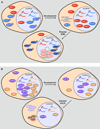Roles for RNA-binding proteins in development and disease
- PMID: 26972534
- PMCID: PMC5003702
- DOI: 10.1016/j.brainres.2016.02.050
Roles for RNA-binding proteins in development and disease
Abstract
RNA-binding protein activities are highly regulated through protein levels, intracellular localization, and post-translation modifications. During development, mRNA processing of specific gene sets is regulated through manipulation of functional RNA-binding protein activities. The impact of altered RNA-binding protein activities also affects human diseases in which there are either a gain-of-function or loss-of-function causes pathogenesis. We will discuss RNA-binding proteins and their normal developmental RNA metabolism and contrast how their function is disrupted in disease. This article is part of a Special Issue entitled SI:RNA Metabolism in Disease.
Keywords: Development; Neurodegenerative disease; Protein aggregate; Protein mis-regulation; RNA processing; RNA-binding protein.
Copyright © 2016 Elsevier B.V. All rights reserved.
Figures

References
-
- Alami NH, Smith RB, Carrasco MA, Williams LA, Winborn CS, Han S, Kiskinis E, Winborn B, Freibaum BD, Kanagaraj A, Clare AJ, Badders NM, Bilican B, Chaum E, Chandran S, Shaw CE, Eggan KC, Maniatis T, Taylor PJ. Axonal Transport of TDP-43 mRNA Granules Is Impaired by ALS-Causing Mutations. Neuron. 2014;81:536–543. - PMC - PubMed
-
- Begemann G, Paricio N, Artero R, Kiss I, Perez-Alonso M, Mlodzik M. muscleblind, a gene required for photoreceptor differentiation in Drosophila, encodes novel nuclear Cys3His-type zinc-finger-containing proteins. Development. 1997;124:4321–4331. - PubMed
-
- Blanc V, Davidson NO. C-to-U RNA editing: mechanisms leading to genetic diversity. J. Biol. Chem. 2003;278:1395–1398. - PubMed
-
- Blencowe BJ. Alternative splicing: new insights from global analyses. Cell. 2006;126:37–47. - PubMed
-
- Brook J, McCurrach M, Harley H, Buckler A, Church D, Aburatani H, Hunter K, Stanton V, Thirion J, Hudson T. Molecular basis of myotonic dystrophy: expansion of a trinucleotide (CTG) repeat at the 3' end of a transcript encoding a protein kinase family member. Cell. 1992;69:385. - PubMed
Publication types
MeSH terms
Substances
Grants and funding
LinkOut - more resources
Full Text Sources
Other Literature Sources
Medical

